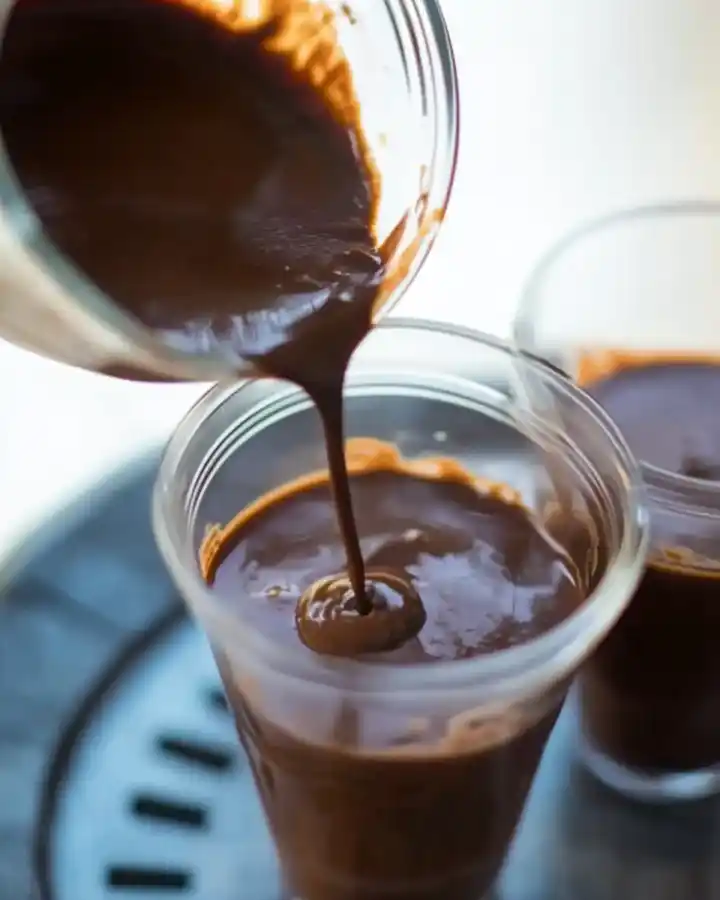The Best Fluffy Pancakes recipe you will fall in love with. Full of tips and tricks to help you make the best pancakes.

Whether you’re craving an indulgent dessert for a dinner party or just want a comforting sweet treat, this homemade chocolate budino will satisfy all your cravings!
In this guide, you’ll discover:
✔️ How to make the creamiest chocolate budino from scratch
✔️ The secret ingredient that gives it a deep chocolate flavor
✔️ How to customize it with toppings and variations
✔️ Storage and make-ahead tips for the perfect dessert
Table of Contents
Let’s get started on this decadent Italian dessert! 🍫✨
Why You’ll Love This Chocolate Budino
✔️ Luxuriously creamy – Silky smooth texture with every bite.
✔️ Deep chocolate flavor – Rich and indulgent, perfect for chocolate lovers.
✔️ Make-ahead friendly – Ideal for prepping in advance for dinner parties.
✔️ Easy to customize – Add caramel, nuts, whipped cream, or sea salt for extra indulgence.
Looking for more chocolate treats? Try Chocolate-Covered Almonds for a crunchy, chocolatey snack!
🛒 Precisely Measured Ingredients
For the Chocolate Budino:
- 2 cups whole milk
- ½ cup heavy cream
- ½ cup granulated sugar
- 2 tablespoons cornstarch
- ¼ teaspoon salt
- 4 ounces dark chocolate (70% cocoa or higher), finely chopped
- 2 tablespoons unsalted butter
- 1 teaspoon vanilla extract
- 2 large egg yolks
For Toppings (Optional but Recommended!):
- Whipped cream
- Shaved chocolate or cocoa powder
- Sea salt flakes
- Caramel drizzle
- Toasted hazelnuts
🔥 Step-by-Step Instructions: How to Make Chocolate Budino
🕒 Prep Time: 10 minutes
⏳ Cook Time: 10 minutes
❄️ Chill Time: 2 hours
🍽️ Yield: 4 servings
Step 1: Heat the Milk & Cream
- In a medium saucepan, combine milk, heavy cream, sugar, and salt.
- Heat over medium heat, stirring occasionally, until the mixture is warm but not boiling.
✔️ Pro Tip: Avoid letting the milk boil, as it can alter the texture.
Step 2: Melt the Chocolate
- Add the chopped dark chocolate to the warm milk mixture.
- Stir continuously until the chocolate is completely melted and smooth.
✔️ Use high-quality dark chocolate for the best flavor!

Step 3: Thicken the Budino
- In a separate bowl, whisk together cornstarch and egg yolks until smooth.
- Slowly pour ½ cup of the warm chocolate mixture into the egg yolk mixture, whisking constantly (this prevents scrambling).
- Pour the egg mixture back into the saucepan.
- Cook over low heat, stirring constantly, until the mixture thickens (about 3-5 minutes).
✔️ Pro Tip: The budino should coat the back of a spoon when ready!


Step 4: Add Butter & Vanilla
- Remove from heat and stir in butter and vanilla extract.
- Mix until completely combined.
✔️ Butter adds richness, and vanilla enhances the chocolate flavor!
Step 5: Chill the Budino
- Pour the pudding into individual serving cups.
- Cover each cup with plastic wrap pressed directly on the surface (prevents a skin from forming).
- Refrigerate for at least 2 hours before serving.


For more Italian desserts, check out Glazed Chocolate Donuts!
Best Ways to Serve Chocolate Budino
🍓 With Fresh Berries: Adds a refreshing contrast.
🍫 With Extra Chocolate Shavings: Because more chocolate is always better!
☕ With Espresso or Coffee: The bitterness balances the sweetness.
Looking for more dessert pairings? Try Milky Cocoa Guide for a warm, chocolatey drink!
The History of Chocolate Budino: An Italian Classic
Chocolate Budino has been a staple of Italian cuisine for centuries. Unlike American pudding, which is often made with gelatin or instant mixes, traditional budino is a rich custard-based dessert that originated in Italy.
Where Did Budino Come From?
The word “budino” is Italian for pudding, and it dates back to the Renaissance era, when Italian chefs created silky-smooth desserts using milk, eggs, and sugar. Over time, chocolate became a favorite addition, and Chocolate Budino became a beloved Italian treat.

Modern Variations of Budino
Today, there are many regional and gourmet variations of budino, including:
✔️ Vanilla Budino – Made with real vanilla beans.
✔️ Salted Caramel Budino – A trendy favorite with a layer of caramel.
✔️ Pistachio Budino – Infused with nutty pistachios.
For more classic Italian desserts, check out Glazed Chocolate Donuts Guide!
How to Make Chocolate Budino Without Cornstarch
If you don’t want to use cornstarch, there are a few simple alternatives that will still give you a thick, creamy texture.
Best Substitutes for Cornstarch in Budino
✔️ Egg Yolks Only – Increase the egg yolks to 4 total for a thicker custard.
✔️ Flour – Use 1 tablespoon of all-purpose flour in place of cornstarch.
✔️ Arrowroot Powder – A great gluten-free thickener, use 2 teaspoons instead of cornstarch.
Looking for more gluten-free options? Try Sweet Potato Chips Guide!
Can You Make Chocolate Budino Without Dairy? (Dairy-Free Version)
Yes! If you’re lactose intolerant or vegan, you can still enjoy a creamy Chocolate Budino. Here’s how:
Dairy-Free Ingredient Swaps
✔️ Milk Substitute – Use coconut milk, almond milk, or oat milk.
✔️ Cream Substitute – Swap heavy cream for full-fat coconut cream.
✔️ Butter Substitute – Use vegan butter or coconut oil.
✔️ Chocolate Substitute – Use dairy-free dark chocolate (70% or higher).
For more plant-based dessert ideas, check out Chocolate-Covered Almonds!
How to Store and Freeze Chocolate Budino
Chocolate Budino is a great make-ahead dessert, and storing it properly ensures it stays fresh and delicious.
Short-Term Storage
✔️ Refrigerator: Store in an airtight container for up to 4 days.
✔️ Cover with plastic wrap touching the surface to prevent a skin from forming.
Long-Term Storage
✔️ Freezer: Store in freezer-safe cups for up to 2 months.
✔️ Thaw in the fridge overnight before serving.
For more make-ahead dessert ideas, check out Banana Bread Cookies!
How to Make Chocolate Budino Extra Thick & Rich
Want an even thicker, more indulgent texture? Try these expert tips:
✔️ Use more egg yolks – Instead of 2, use 3 egg yolks for a denser custard.
✔️ Double the chocolate – Add an extra ounce of dark chocolate for a deeper flavor.
✔️ Use heavy cream only – Replace milk with all heavy cream for ultra-richness.
✔️ Simmer longer – Cook the budino for an extra 3-5 minutes for a firmer texture.

Looking for more rich chocolate recipes? Try Best Jar Alfredo Sauce Guide for another creamy indulgence!
Chocolate Budino vs. Chocolate Mousse: What’s the Difference?
Although Chocolate Budino and Chocolate Mousse look similar, they have key differences:
| Feature | Chocolate Budino | Chocolate Mousse |
|---|---|---|
| Texture | Silky, pudding-like | Light, airy, and fluffy |
| Main Ingredient | Egg yolks & milk | Whipped cream & egg whites |
| Cooking Method | Cooked on stovetop | Usually chilled, no cooking required |
| Richness Level | Dense and creamy | Light and airy |
Looking for more chocolate desserts? Check out Milky Cocoa Guide!
Best Wines & Drinks to Pair with Chocolate Budino
Pairing Chocolate Budino with the right drink enhances the experience.
Perfect Drink Pairings
🍷 Red Wine: A bold Cabernet Sauvignon or Port pairs beautifully.
☕ Espresso: The bitterness balances the sweetness.
🥛 Vanilla Almond Milk: A dairy-free, nutty contrast.
For more drink ideas, check out Pink Drink Guide!
Common Mistakes to Avoid When Making Chocolate Budino
Want perfectly smooth budino every time? Avoid these common mistakes:
❌ Boiling the milk – High heat can cause the mixture to curdle.
❌ Skipping the egg tempering step – Slowly whisking warm milk into egg yolks prevents scrambling.
❌ Not stirring enough – Consistent stirring ensures an even, smooth texture.
❌ Using low-quality chocolate – Always use high-quality dark chocolate (70%+ cocoa) for the best taste.
For more dessert-making tips, check out Ghirardelli Brownie Mix Guide!
FAQs About Chocolate Budino
What’s the difference between budino and regular chocolate pudding?
Budino is thicker and silkier than regular pudding, with a custard-like texture.
Can I make chocolate budino without eggs?
Yes! Increase cornstarch to 3 tablespoons for a smooth, thick texture.
How long does chocolate budino last in the fridge?
It stays fresh for up to 4 days when stored in an airtight container.
Can I make this in advance for a party?
Yes! Chocolate budino is perfect for making ahead since it needs time to chill.
What’s the best chocolate to use for budino?
Use 70% dark chocolate or higher for the richest flavor.
Final Thoughts: The Perfect Chocolate Budino
This Chocolate Budino is the ultimate creamy chocolate dessert—perfect for an elegant dinner or a cozy night in. With simple ingredients and easy steps, you can whip up this silky, rich pudding anytime!
🔥 Now it’s your turn! Try this recipe and let us know your favorite toppings!
For more chocolatey treats, check out Banana Bread Cookies for another homemade delight! 🍫🍪🎉







[…] in some dark chocolate chips or stir in chocolate budino mix for a silky […]